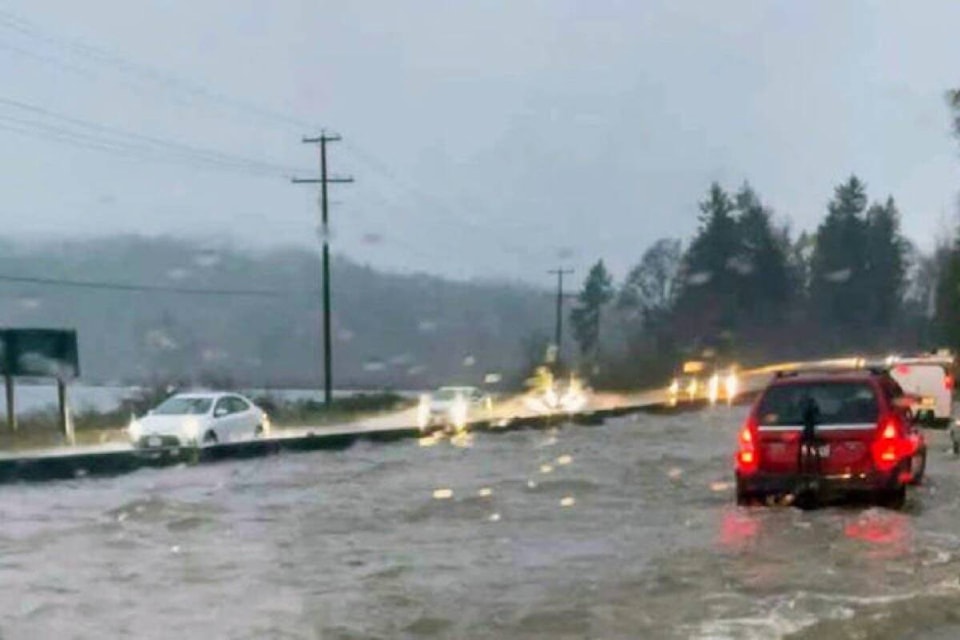The province now has a plan in place to deal with the flooding on the Trans-Canada Highway south of Mount Sicker Road in the event of flooding like the region experienced on Nov. 15.
North Cowichan Mayor Al Siebring said at the council meeting on Dec. 1 that after talking to residents in the Mount Sicker Road area after the flooding that saw the TCH closed down for approximately eight hours, he asked the Ministry of Transportation and Infrastructure to remove some of the concrete barricades in the middle of the highway south of Mount Sicker Road during flooding events to allow the water to move freely across the road, and MOTI agreed.
RELATED STORY: RAIN FINALLY SUBSIDES, BUT FLOOD DAMAGE EXTENSIVE IN COWICHAN
Westholme Road, the Halalt First Nation, Tussie Road, sections along the Chemainus River, Pinson’s Corner, Quist Farms, Russell Farm, Katie Farm and lower Mount Sicker Road were flooded in the quickly rising water.
“During the flooding a few weeks ago and also in January of last year, the volume of water was so great in that area that the water was spilling over the concrete barricades in the middle of the highway,” Siebring said.
“That overflow continued until the volume of water extended further south and the accumulated weight became so great, the barriers were literally pushed out of the way into the northbound lanes of the highway. Prior to that, the water level rose almost two-and-a-half feet to reach the top of the barricades and that created higher-water levels and more flooding for people on the west side of the highway.”
RELATED STORY: ALL HANDS ON DECK FOR WESTHOLME FLOOD PREPARATIONS
Siebring said that as soon as the concrete barriers were shifted by the weight of the water, the water levels on the west side of the highway dropped more than two feet and stayed lower for the duration of the day.
“I suggested to MOTI that the barriers should be preemptively removed as soon as sensors indicate that high-water levels will be approaching the highway to allow the water to move more freely across the road,” he said.
“I have received confirmation from MOTI that a plan is now in place to proactively move the centre barriers on the highway south of Mount Sicker Road when a trigger point is reached. When this takes place, MOTI will also close the highway.”
RELATED STORY: CVRD LOOKS TO MOVE FORWARD WITH FLOOD MAPPING OF CHEMAINUS RIVER
At least one farmer in the area thinks the plan is a good idea.
David Quist, who owns Quist Farms which has property on the east side of the TCH just south of Mount Sicker Road, said that his land was severely damaged due to the flooding on Nov. 15 and last January.
He said the flooding on his property was made more severe by having the concrete barriers on the highway in place.
“Letting the water on the west side of the barriers build up to two-and-half feet and then having it rush across the highway all at once carrying rocks and other debris does a lot more damage to my property than having the water flow freely across the road, so removing the barriers before the water builds up is probably a good idea,” he said.
Quist said last January’s flooding cost him approximately $70,000 in damages, and he figures it’s about the same amount again after the event on Nov. 15.
“After last year’s flooding, the province came up with a relief fund for those impacted by the floods,” he said.
“I spent two weeks filling out paperwork, but the province denied my application because we are incorporated. I don’t know if there is a relief fund this time, but I have no time to spend another two weeks filling out more paperwork on an application that will likely be denied again.”
robert.barron@cowichanvalleycitizen.com
Like us on Facebook and follow us on Twitter
